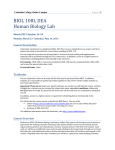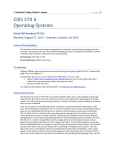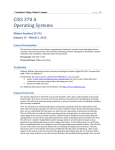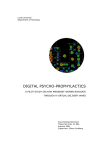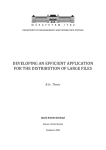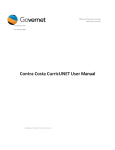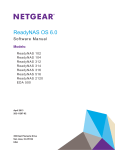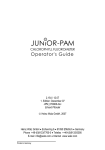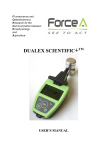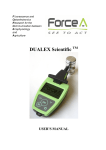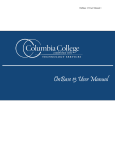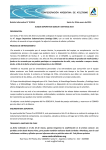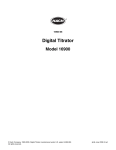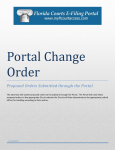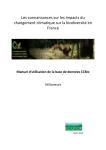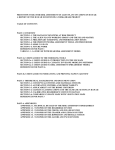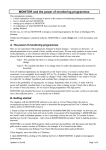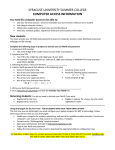Download BIOL 115L A Environmental Science Laboratory
Transcript
Columbia College Online Campus Page |1 BIOL 115L A Environmental Science Laboratory Early Fall Session 15-51 Monday, August 17 - Saturday, October 10, 2015 Course Description Laboratory experiences to complement BIOL/ENVS 115. You are required to purchase an at-home lab kit. Readings for this course are provided under the course Content. In addition, access to a digital camera is required for submitting photos electronically to the instructor. Cross-listed as BIOL 115L and ENVS 115L. Prerequisite: BIOL/ENVS 115 or concurrent enrollment. BIOL/ENVS 115 must be taken as a corequisite or completed before BIOL/ENVS 115L can be used as General Education credit. G.E. Proctored Exams: -- none Textbooks You are required to order an at-home Lab Kit. Kits may be purchased from MBS Direct. In addition, you are responsible for gathering weekly supplies for labs. These will be readily available at your local supermarket. Important! Please do not order your Lab Kit until you are certain you will take this course. Lab Kits, if eligible for a refund, may be returned for refund only under very strict conditions, within only two (2) weeks of receipt. So, please do not order your Lab Kit until you are committed to taking this course! In addition, access to a digital camera is required for submitting photos electronically to the instructor. The Lab Kit for the course may be ordered from MBS Direct. You can order online at http://direct.mbsbooks.com/columbia.htm (be sure to select Online Education rather than your home campus before selecting your class) by phone at 800-325-3252 For additional information about the bookstore, visit http://www.mbsbooks.com. Columbia College Online Campus Page |2 Course Overview Welcome to BIOL 115L Environmental Science Laboratory, online! This course will introduce you to hands-on approaches for studying basic laboratory techniques, population growth, soils and agriculture, macrobiomes, climate changes and acid rain, water as a resource, and how humans interact with their environment. Each week we will focus on different issues and concepts relating to the environment through our at-home laboratory kit, with additional online activities and discussions that will reinforce and expand on lab content. Hopefully when this class is finished, you will have a good basic understanding of environmental science and our impact on the environment. We will cover the following topics: Week 1 – Setting up a Safe Lab; Laboratory Techniques and Measurements Week 2 – Water, pH and Buffers; Population Ecology Week 3 – Properties of Soils; Agroforestry Case Study Week 4 – Biomes, Ecosystems, and Habitats; Food Web Week 5 – Climate Change and the Scientific Method; Acid Rain Week 6 – Seawater and Freshwater Week 7 – Endangered Species Week 8 – Carbon Footprint and Sustainable Living Technology Requirements Participation in this course will require the basic technology for all online classes at Columbia College: A computer with reliable Internet access, a web browser, Acrobat Reader, Microsoft Office or another word processor such as Open Office. You can find more details about standard technical requirements for our courses on our site. Digital Photo Documentation Capability: Most of your lab reports will require digital photographs to document various steps of the experiments or show hand-drawn observations. You must have digital photography capability. Course Objectives To apply the basic principles of ecology to real world issues. To explore ecological and environmental topics in depth through discussion, critical analysis and experimentation. To evaluate the role and impact of humans on natural systems. Apply the scientific method through experimentation and research. Measurable Learning Outcomes Make a presentation using primary literature pertaining to a project applying the scientific method. Write a paper using primary literature pertaining to a project applying the scientific method. Columbia College Online Campus Page |3 Grading Grading Scale Grade Weights GRADE POINTS PERCENT ASSIGNMENT POINTS PERCENT A 473-525 90-100 Discussions 160 30% 315 60% B 420-472 80-89 Dropbox Assignments C 368-419 70-79 50 10% D 315-367 60-69 Endangered Species Paper F 0-314 0-59 Total 525 100% Schedule of Due Dates WEEK ASSIGNMENT POINTS DUE DATE Dropbox Assignment (Lab Safety Agreement) 5 Thurs Dropbox Assignment (LabPaq Contents List) 15 Thurs Discussion 1 10 Thurs Dropbox Assignment (Photo Set- Lab 1) 5 Thurs Dropbox Assignment (Prelab Hazard Assessment) 5 Fri Dropbox Assignment (Lab Report Assistant) 20 Sun Dropbox Assignment (Photo Set- Lab 2) 5 Sun Discussion 2 10 Sun Dropbox Assignment (Prelab Hazard Assessment) 5 Wed Dropbox Assignment (Lab Report Assistant) 20 Thurs Dropbox Assignment (Photo Set- Lab 3) 5 Thurs Discussion 3 10 Thurs Dropbox Assignment (Lab Report Assistant) 20 Sun Discussion 4 10 Sun Discussion 5 10 Sun Dropbox Assignment (Endangered Species Paragraph) 15 Sun Dropbox Assignment (Prelab Hazard Assessment) 5 Wed Dropbox Assignment (Lab Report Assistant) 20 Thurs Dropbox Assignment (Photo Set- Lab 5) 5 Thurs Discussion 6 10 Thurs Dropbox Assignment (Agroforestry Case Study) 15 Sun Lab 1: Setting up a Safe Lab 1 Lab 2: Laboratory Techniques and Measurements Lab 3: Water, pH and Buffers 2 Lab 4: Population Ecology Lab 5: Properties of Soils 3 Columbia College Online Campus Page |4 Lab 6: Biomes, Ecosystems and Habitats 4 Dropbox Assignment (Lab Report Assistant) 20 Thurs Dropbox Assignment (Photo Set- Lab 6) 5 Thurs Discussion 7 10 Thurs Dropbox Assignment (Lab Report Assistant) 20 Sun Dropbox Assignment (Photo Set- Lab 7) 5 Sun Discussion 8 10 Sun Dropbox Assignment (Lab Report Assistant) 20 Thurs Discussion 9 10 Thurs Discussion 10 10 Thurs Dropbox Assignment (Prelab Hazard Assessment) 5 Fri Dropbox Assignment (Lab Report Assistant) 20 Sun Dropbox Assignment (Photo Set- Lab 9) 5 Sun Discussion 11 10 Sun 20 Sun Dropbox Assignment (Photo Set- Lab 10) 5 Sun Discussion 12 10 Sun Discussion 13 10 Sun Dropbox Assignment (Photo Set- Endangered Species) 5 Sun Discussion 14 10 Sun Endangered Species Paper 50 Sun Dropbox Assignment (Lab Report Assistant) 20 Fri Discussion 15 10 Fri 10 Fri Lab 7: The Food Web Lab 8: Climate Change and the Scientific Method 5 Lab 9: Acid Rain Lab 10: Seawater and Fresh Water Dropbox Assignment (Lab Report Assistant) 6 Endangered Species 7 Lab 11: Carbon Footprint and Sustainable Living 8 Discussion 16 TOTAL 525 Columbia College Online Campus Page |5 Assignment Overview Readings under course Content should be completed prior to submitting assignments or weekly discussion postings. All graded assignments will rely on information derived from the readings and online research. During weeks when two labs will be completed, the first lab will be conducted Monday through Thursday, and the second lab will be conducted Thursday through Sunday. Check the schedule below for specific due dates for quizzes, assignments, and discussion questions. Activities: There will be weekly class activities and/or lab activities associated with preparing for course assignments and conducting the labs. Please complete the class and lab activities as indicated for each week. Discussion: Discussion postings should be completed by Thursday or Sunday of each assigned week, depending on the lab schedule. Discussion postings will be graded according to the Grading Criteria. Dropbox Assignments must be completed and posted to the appropriate folder in the Dropbox area of the course by the due dates given each week. The criteria are detailed in the Grading Criteria. Dropbox Assignment descriptions are as follows: Lab Report Assistants are required for most labs. For each week requiring this assignment, you will find a Lab Report Assistant template. This report basically includes all the questions and tables that you should fill out as you work your way through the lab. As you complete the lab, fill out these questions, data tables, graphs, etc. Each Lab Report Assistant should be submitted to the appropriate folder in the Dropbox no later than the assigned due date. Photo Sets: Photo documentation is required for certain steps of most labs. Required photos include documenting various steps of the experiments, hand-drawn observations, or personal observations. Digital photos should be pasted into a Word document, and grouped together on a single page for each lab. In the Content Area of the course, you will find a document called Required Photo Sets. This is a week-by-week list of required photos to be submitted based on each lab. The required photos that are specific steps of an experiment should be embedded directly into the Lab Report Assistant. Other required photos are to be pasted into a Word document and submitted to the appropriate Dropbox each week. Prelab Hazard Assessments: Some labs will require a Prelab Hazard Assessment to be completed. Use the Prelab Hazard Assessment Template found under course Content. This assessment involves reviewing possible safety hazards for each lab, researching any potentially harmful chemicals using the MSDS information provided in the Safety module under course Content. Each Prelab Hazard Assessment should be submitted to the appropriate folder in the Dropbox no later than the assigned due date. Other Dropbox Assignments: Lab Safety Agreement, LabPaq Contents List, Endangered Species Paragraph, and Agroforestry Case Study. These Dropbox Assignments should be completed according to the instructions provided in the course, and then submitted to the appropriate folder in the Dropbox area of the course by each assigned due date. Endangered Species Paper: You will choose one species listed as threatened or endangered in the U.S. or globally and write a 2-3 page paper on this species, including its name, habitat, current threats, historical background, conservation efforts, and other important information. You will include a list of at least 3 references. Full details for this paper are available in the course Content area. Your paper should be submitted to the appropriate folder in the Dropbox no later than the assigned due date. Columbia College Online Campus Page |6 Course Schedule Week 1 – Setting up a Safe Lab; Laboratory Techniques and Measurements Activities: Complete the following activities. Weekly Shopping List: In the Content area of the course, you will find a document called “Weekly Shopping List”. This is a week-by-week list of supplies that you must provide. Print this off and make sure to find or purchase supplies needed for each week. Tour the College's Website - http://www.ccis.edu/. Next, take a look at your reference page. Become comfortable with techniques of email management (using your browser's email capability). This is very important because we will be using a lot of email in this course. Review the lab manual and become familiar with its resources. Lab 1: Setting up your home laboratory Readings: Complete the following readings found under in the course Content. General Information: Review the Introduction and the list of required photos. Safety: In this module you will find several important documents on lab safety. Review all material, especially How to Read MSDS, Safety Information, and the Lab Safety Contract. Appendices: Review the Introduction to Lab Equipment and Techniques. Week 1: Read the Instructor Notes for this lab, as well as the Instructor Slideshow found in the Content area of the course. Activities: Open your kit and examine the contents. Watch the Unpacking Your Kit video. Finally, watch the Safety video. Dropbox Assignments: Complete the following Dropbox Assignments, and submit each to their corresponding folders in the Dropbox area of the course. Confirm the due date of each assignment on the Schedule of Due Dates table above. Lab Safety Contract: In the Content area of the course, under Safety, you will find a Lab Safety Contract. Complete this, making sure it is initialed and “signed.” LabPaq Contents List: Using the Contents List provided with your kit, remove each item from the kit and check it off the list. Complete your check of the LabPaq Contents List. Make sure it is checked and initialed. Scan or photograph the initialed sheet and submit to the appropriate dropbox. Dropbox Assignment (Photo Set- Lab 1): For this lab, submit a photo of you with your kit in your home lab. Discussion 1: Describe your home laboratory. Why did you choose this area? What are the potential problems with using this area? How might you resolve those problems? Lab 2: Laboratory Techniques and Measurements Readings: Complete the following readings. Lab 2: Read Experiment - Laboratory Techniques and Measurements. Also, review the Instructor Notes and Instructor Slideshow for this lab. Review any relevant Safety information, such as MSDS. Other Readings: Read the User’s Manual for the Digital Pocket Scale. Activities: After reading the lab, go through the lab kit and find all items listed on the first page of the lab. Also, gather any supplies listed under “student provides.” Once all materials are laid out, you can begin the lab. You will learn about the International System of Units (SI) system and how it relates to measurements in mass, length, temperature, volume, and time. You will learn about the common Columbia College Online Campus Page |7 techniques and laboratory equipment used to make SI measurements. You will use the laboratory equipment to make measurements such as temperature and density, prepare dilutions, and calculate the concentrations of the dilutions using the M1V1 = M2V2 equation. Dropbox Assignment (Prelab Hazard Assessment): Review potential hazards of this lab, both chemical and physical. Using the Prelab Hazard Assessment Template, make note of each hazard, discuss WHY it is hazardous, and HOW you will avoid potential problems. Confirm the due date of each assignment on the Schedule of Due Dates table above. Discussion 2 - Post Lab reflection: What worked? What problems did you encounter? What might you do differently if you were to do this again? What insights did you gain? Dropbox Assignment (Lab Report Assistant): As you complete the lab, fill out the associated Lab Report Assistant, and submit it to the appropriate folder in the Dropbox. Dropbox Assignment (Photo Set- Lab 2): Paste the required photos into a Word document. Photos to submit include a photo of all kit materials needed for this lab and all other materials provided by you in your workspace. Submit the set to the appropriate folder in the Dropbox area of the course. Week 2– Water, pH and Buffers ; Population Ecology; Endangered Species Lab 3: Water, pH and Buffers Readings: Complete the following readings. Lab 3: Read Experiment - Water, pH, and Buffers. Also, review the Instructor Notes and Instructor Slideshow for this lab. Review any relevant Safety information, such as MSDS. Other Readings: Read the Instructor Notes for this lab, found in the Content area of the course, as well as the Instructor Slide Show. Activities: You will explore some unique characteristics of water, learn about pH, and evaluate the effect of buffers on a solution. You will learn how anthocyanins from red cabbage can be extracted and used to prepare homemade pH indicator strips. You will demonstrate how water can travel up the stems of a plant, investigate the pH of common household materials, and explore the effects of a buffer on pH. Complete the following Dropbox Assignments, and submit each to their corresponding folders in the Dropbox area of the course. Confirm the due date of each assignment on the Schedule of Due Dates table above. Dropbox Assignment (Prelab Hazard Assessment): Review potential hazards of this lab, both chemical and physical. Using the Prelab Hazard Assessment Template, make note of each hazard, discuss WHY it is hazardous, and HOW you will avoid potential problems. Submit this to the appropriate folder in the Dropbox. Dropbox Assignment (Lab Report Assistant): As you complete the lab, fill out the associated Lab Report Assistant, and submit it to the appropriate folder in the Dropbox . Dropbox Assignment (Photo Set- Lab 3): Paste the required photos into a Word document and submit to the appropriate Dropbox. Photos to submit include a picture of your celery after 4 hours of incubation, and your 12-well plate filled with household items for pH testing, along with the 12 commercial pH test strips after testing and the 12 homemade test strips after testing. Discussion 3 - Post Lab reflection: What worked? What problems did you encounter? What might you do differently if you were to do this again? What insights did you gain? Lab 4: Population Ecology Readings: Complete the following readings. Columbia College Online Campus Page |8 Lab 4: Read Experiment - Population Ecology. Other Readings: Read the Instructor Notes for this lab, found in the Content area of the course. Also, read ‘ESA: The Basics’ on the Endangered Species Act in the Content area. Activities: You will explore the concepts of population ecology. They will learn the quantitative nature of demographics and learn how density-independent and density-dependent variables affect population growth. You will model exponential population growth and learn how population size is estimated. Complete the following Dropbox Assignments, and submit each to their corresponding folders in the Dropbox area of the course. Confirm the due date of each assignment on the Schedule of Due Dates table above. Dropbox Assignment (Lab Report Assistant): As you complete the lab, fill out the associated Lab Report Assistant, and submit it to the appropriate folder in the Dropbox. Discussion 4 - Post Lab reflection: What worked? What problems did you encounter? What might you do differently if you were to do this again? What insights did you gain? Discussion 5 - Human Population Growth: view the BBC video clip Hans Rosling's 200 Countries, 200 Years, 4 Minutes. Discuss your opinion of human population growth, wealth, and current trends for the growth and health of the human population on Earth. http://www.bbc.co.uk/programmes/p00cgkfk Dropbox Assignment (Endangered Species Paragraph): After reading ‘ESA: The Basics’ on the Endangered Species Act, select a threatened or endangered species to research. Turn in a one paragraph description of your species and why you chose it. You will turn in a 2-3 paper on your selected species on Sunday of Week 7. Week 3– Properties of Soils; Agroforestry Lab 5: Properties of Soils Readings: Complete the following readings from the Lab Manual, LabPaq CD, and Other Readings. Lab 5: Read Experiment - Properties of Soils. Review any relevant Safety information, such as MSDS. Other Readings: Read the Instructor Notes for this lab, found in the Content area of the course. Activities: You will test soils for nutrients, texture, and pH, as well as test to determine the suitability of each soil for plant growth. Complete the following Dropbox Assignments, and submit each to their corresponding folders in the Dropbox area of the course. Confirm the due date of each assignment on the Schedule of Due Dates table above. Dropbox Assignment (Prelab Hazard Assessment): Review potential hazards of this lab, both chemical and physical. Using the Prelab Hazard Assessment Template, make note of each hazard, discuss WHY it is hazardous, and HOW you will avoid potential problems. Submit this to the appropriate folder in the Dropbox. Dropbox Assignment (Lab Report Assistant): As you complete the lab, fill out the associated Lab Report Assistant, and submit it to the appropriate folder in the Dropbox. Dropbox Assignment (Photo Set- Lab 5): Paste the required photos into a Word document and submit to the appropriate Dropbox. Photos to submit include results of soil pH, nutrients, and soil texture experiments. Discussion 6 - Post Lab reflection: What worked? What problems did you encounter? What might you do differently if you were to do this again? What insights did you gain? Columbia College Online Campus Page |9 Dropbox Assignment (Agroforestry Case Study): Banana Split: To Eat or Not To Eat. Read the case study, and then complete the Banana Split Questions. Submit completed questions to the Drobox. Week 4– Biomes, Ecosystems, and Habitats; Food Web Lab 6: Biomes, Ecosystems, and Habitats Readings: Complete the following readings. Lab 6: Read Experiment – Biomes, Ecosystems, and Habitats Other Readings: Read the Instructor Notes for this lab, as well as the Instructor Slideshow, found in the Content area of the course. Activities: You will examine the five major biomes of the world and their key characteristics as well as study their home biomes. When weather permits, you will examine their home habitat; when weather is not favorable, you will conduct internet research on local habitats. You will stake out quadrats in two study areas, record the observed fauna and flora, and collect and analyze soil samples. Complete the following Dropbox Assignments, and submit each to their corresponding folders in the Dropbox area of the course. Confirm the due date of each assignment on the Schedule of Due Dates table above. Dropbox Assignment (Lab Report Assistant): As you complete the lab, fill out the associated Lab Report Assistant, and submit it to the appropriate folder in the Dropbox. Dropbox Assignment (Photo Set- Lab 6): Paste the required photos into a Word document and submit to the appropriate folder in the Dropbox. Photos to submit include images of your two study quadrats. Discussion 7 - Post Lab reflection: What worked? What problems did you encounter? What might you do differently if you were to do this again? What insights did you gain? Lab 7: The Food Web Readings: Complete the following readings. Lab 7: Read Experiment - The Food Web. Other Readings: Read the Instructor Notes for this lab, found in the Content area of the course. Activities: In this experiment you will learn about food chains and food webs. Specifically, you will study birds of prey and their diets. Each student will dissect an owl pellet and relate the organisms consumed by the owl to the type of prey located within a certain habitat. Complete the following Dropbox Assignments, and submit each to their corresponding folders in the Dropbox area of the course. Confirm the due date of each assignment on the Schedule of Due Dates table above. Dropbox Assignment (Lab Report Assistant): As you complete the lab, fill out the associated Lab Report Assistant, and submit it to the appropriate folder in the Dropbox. Dropbox Assignment (Photo Set- Lab 7): Paste the required photos into a Word document and submit to the appropriate Dropbox. Photos to submit include a picture of the bones from your owl pellet. Discussion 8 - Post Lab reflection: What worked? What problems did you encounter? What might you do differently if you were to do this again? What insights did you gain? Columbia College Online Campus P a g e | 10 Week 5– Climate Change and the Scientific Method; Acid Rain Lab 8: Climate Change and the Scientific Method Readings: Complete the following readings. Lab 8: Read Experiment - Climate Change and the Scientific Method Other Readings: Read the Instructor Notes for this lab, found in the Content area of the course. Activities: You will have the opportunity to analyze six soil samples with simulated pollen grains as a means to determine the climate changes that have occurred in a region over time. You will use data collected in the soil pollen analysis to better understand the use of the scientific method in hypothesis formulation and testing. Complete the following Dropbox Assignments, and submit each to their corresponding folders in the Dropbox area of the course. Confirm the due date of each assignment on the Schedule of Due Dates table above. Dropbox Assignment (Lab Report Assistant): As you complete the lab, fill out the associated Lab Report Assistant, and submit it to the appropriate folder in the Dropbox. Discussion 9: Climate change continues to be a controversial political topic. Discuss your opinion of this issue, including what you consider trusted sources of information. Discussion 10 - Post Lab reflection: What worked? What problems did you encounter? What might you do differently if you were to do this again? What insights did you gain? Lab 9: Acid Rain Readings: Complete the following readings. Lab Manual: Read Experiment - Acid Rain. Review any relevant Safety information, such as MSDS. Other Readings: Read the Instructor Notes for this lab, found in the Content area of the course. Activities: You will learn about the pH scale and the causes and effects of acid rain. You will simulate acid rain by creating a microenvironment, which produces both sulfur oxide and nitrogen oxide gases. Using Bromcresol green, each student will learn how to test for acidic solutions. They will investigate the buffering effects of calcium carbonate in the environment. Finally, you will study how acid rain affects different types of rocks. Complete the following Dropbox Assignments, and submit each to their corresponding folders in the Dropbox area of the course. Confirm the due date of each assignment on the Schedule of Due Dates table above. Dropbox Assignment (Prelab Hazard Assessment): Review potential hazards of this lab, both chemical and physical. Using the Prelab Hazard Assessment Template, make note of each hazard, discuss WHY it is hazardous, and HOW you will avoid potential problems. Submit this to the appropriate folder in the Dropbox.. Dropbox Assignment (Lab Report Assistant): As you complete the lab, fill out the associated Lab Report Assistant, and submit it to the appropriate folder in the Dropbox. Dropbox Assignment (Photo Set- Lab 9): Paste the required photos into a Word document and submit to the appropriate Dropbox. Photos to submit include beginning and ending photos of your nitrogen oxides, sulfur dioxide, and buffering experiments. Discussion 11 - Post Lab reflection: What worked? What problems did you encounter? What might you do differently if you were to do this again? What insights did you gain? Columbia College Online Campus P a g e | 11 Week 6– Seawater and Freshwater Course Evaluations: Please evaluate the course. A link will be sent to your CougarMail that will allow you to access the evaluation. Lab 10: Seawater and Freshwater Readings: Complete the following readings. Lab 10: Read Experiment - Seawater and Freshwater. Other Readings: Read the Instructor Notes for this lab, found in the Content area of the course. Activities: You will have the opportunity to learn about the properties of salt and fresh water and the interaction between both types in the environment. You will investigate salt and freshwater water mixing at deltas and estuaries and study how salt water encroachment endangers coastline wells. You will use ice, wood, and pumice rock to measure the densities of freshwater and saltwater and compare differences in buoyancy. Complete the following Dropbox Assignments, and submit each to their corresponding folders in the Dropbox area of the course. Confirm the due date of each assignment on the Schedule of Due Dates table above. Dropbox Assignment (Lab Report Assistant): As you complete the lab, fill out the associated Lab Report Assistant, and submit it to the appropriate folder in the Dropbox. Dropbox Assignment (Photo Set- Lab 10): Paste the required photos into a Word document and submit to the appropriate Dropbox. Photos to submit include a photo of all kit materials needed for this lab and all other materials provided by you in your workspace. Submit this to the Dropbox. Discussion 12: Where does your water come from? Discuss where your local community gets its household water from, and where it goes when it leaves your home. Discussion 13 - Post Lab reflection: What worked? What problems did you encounter? What might you do differently if you were to do this again? What insights did you gain? Week 7– Endangered Species Readings: Complete the following readings. Other Readings: read ‘ESA: The Basics’ on the Endangered Species Act, and the Endangered Species Assignment in the Content area of the course. Complete the following Dropbox Assignments, and submit each to their corresponding folders in the Dropbox area of the course. Confirm the due date of each assignment on the Schedule of Due Dates table above. Dropbox Assignment (Photo Set- Endangered Species): You will find the required photos this week online. Paste the required photos into a Word document and submit to the appropriate Dropbox. Photos to submit include a photo of the endangered species you chose for your paper, and a picture of its current range. Submit this to the Dropbox. Discussion 14: Introduce your species to the other students in class, and explain some basic information about your species. Endangered Species Paper: Complete a 2-3 page paper on the endangered species you selected during Week 2. Columbia College Online Campus P a g e | 12 Week 8– Carbon Footprint and Sustainable Living Lab 11: Carbon Footprint and Sustainable Living Readings: Complete the following readings. Lab 11: Read Experiment – Carbon Footprint and Sustainable Living. Other Readings: Read the Instructor Notes for this lab, found in the Content area of the course. Also, read Final Cleanup Instructions found with Week 8 materials. Activities: You will investigate how your daily activities impact the environment. You will also calculate your carbon footprint and then determine how you can alter your habits to live a more sustainable life. Note: this lab requires a minimum of FOUR days to complete. Complete the following Dropbox Assignments, and submit each to their corresponding folders in the Dropbox area of the course. Confirm the due date of each assignment on the Schedule of Due Dates table above. Dropbox Assignment (Lab Report Assistant): As you complete the lab, fill out the associated Lab Report Assistant, and submit it to the appropriate folder in the Dropbox. Discussion 15: Using one of the carbon footprint calculators described in the lab readings, discuss your own carbon footprint. What about your lifestyle contributes the most towards you footprint? What one thing would be the easiest to change dramatically? Discussion 16 - Post Lab reflection: What worked? What problems did you encounter? What might you do differently if you were to do this again? What insights did you gain? Course Policies Student Conduct All Columbia College students, whether enrolled in a land-based or online course, are responsible for behaving in a manner consistent with Columbia College's Student Conduct Code and Acceptable Use Policy. Students violating these policies will be referred to the office of Student Affairs and/or the office of Academic Affairs for possible disciplinary action. The Student Code of Conduct and the Computer Use Policy for students can be found in the Columbia College Student Handbook. The Handbook is available online; you can also obtain a copy by calling the Student Affairs office (Campus Life) at 573-875-7400. The teacher maintains the right to manage a positive learning environment, and all students must adhere to the conventions of online etiquette. Plagiarism Your grade will be based in large part on the originality of your ideas and your written presentation of these ideas. Presenting the words, ideas, or expression of another in any form as your own is plagiarism. Students who fail to properly give credit for information contained in their written work (papers, journals, exams, etc.) are violating the intellectual property rights of the original author. For proper citation of the original authors, you should reference the appropriate publication manual for your degree program or course (APA, MLA, etc.). Violations are taken seriously in higher education and may result in a failing grade on the assignment, a grade of "F" for the course, or dismissal from the College. Collaboration conducted between students without prior permission from the instructor is considered plagiarism and will be treated as such. Spouses and roommates taking the same course should be particularly careful. All required papers may be submitted for textual similarity review to Turnitin.com for the detection Columbia College Online Campus P a g e | 13 of plagiarism. All submitted papers may be included in the Turnitin.com reference database for the purpose of detecting plagiarism. This service is subject to the Terms and Conditions of Use posted on the Turnitin.com site. Non-Discrimination There will be no discrimination on the basis of sex, race, color, national origin, sexual orientation, religion, ideology, political affiliation, veteran status, age, physical handicap, or marital status. Disability Services Students with documented disabilities who may need academic services for this course are required to register with the Coordinator for Disability Services at (573) 875-7626. Until the student has been cleared through the disability services office, accommodations do not have to be granted. If you are a student who has a documented disability, it is important for you to read the entire syllabus before enrolling in the course. The structure or the content of the course may make an accommodation not feasible. Online Participation You are expected to read the assigned texts and participate in the discussions and other course activities each week. Assignments should be posted by the due dates stated on the grading schedule in your syllabus. If an emergency arises that prevents you from participating in class, please let your instructor know as soon as possible. Attendance Policy Attendance for a week will be counted as having submitted a course assignment for which points have been earned during that week of the session or if the proctoring information has been submitted or the plagiarism quiz taken if there is no other assignment due that week. A class week is defined as the period of time between Monday and Sunday (except for Week 8, when the week and the course will end on Saturday at midnight). The course and system deadlines are all based on the Central Time Zone. Cougar E-mail All students are provided a CougarMail account when they enroll in classes at Columbia College. You are responsible for monitoring e-mail from that account for important messages from the College and from your instructor. You may forward your Cougar e-mail account to another account; however, the College cannot be held responsible for breaches in security or service interruptions with other e-mail providers. Students should use e-mail for private messages to the instructor and other students. The class discussions are for public messages so the class members can each see what others have to say about any given topic and respond. Late Assignment Policy An online class requires regular participation and a commitment to your instructor and your classmates to regularly engage in the reading, discussion and writing assignments. Although most of the online communication for this course is asynchronous, you must be able to commit to the schedule of work for the class for the next eight weeks. You must keep up with the schedule of reading and writing to successfully complete the class. No late assignments will be accepted without a penalty assessment unless there are truly extenuating circumstances beyond the control of the student. I will count off 20% of the total points possible for dropbox assignments, discussions, or papers each day they are late (11:59 p.m. CT marks the end of a day). Columbia College Online Campus P a g e | 14 Course Evaluation You will have an opportunity to evaluate the course near the end of the session. A link will be sent to your CougarMail that will allow you to access the evaluation. Be assured that the evaluations are anonymous and that your instructor will not be able to see them until after final grades are submitted. Additional Resources Orientation for New Students This course is offered online, using course management software provided by Desire2Learn and Columbia College. The Student Manual provides details about taking an online course at Columbia College. You may also want to visit the course demonstration to view a sample course before this one opens. Technical Support If you have problems accessing the course or posting your assignments, contact your instructor, the Columbia College Helpdesk, or the D2L Helpdesk for assistance. Contact information is also available within the online course environment. [email protected] [email protected] 800-231-2391 ex. 4357 877-325-7778 Online Tutoring Smarthinking is a free online tutoring service available to all Columbia College students. Smarthinking provides real-time online tutoring and homework help for Math, English, and Writing. Smarthinking also provides access to live tutorials in writing and math, as well as a full range of study resources, including writing manuals, sample problems, and study skills manuals. You can access the service from wherever you have a connection to the Internet. I encourage you to take advantage of this free service provided by the college. Access Smarthinking through CougarTrack under Students->Academics->Academic Resources. Grading Criteria Discussion Criteria Description Initial Response Answers are complete, concise, and demonstrate familiarity with the readings. Points 5 Response to Classmates Responses to classmates are substantive and help to advance the discussion and/or our understanding of the subject. Responses pose questions or respond to questions of classmates. At least two responses for each topic are required for full points. 3 Participation The number and timeliness of posts submitted and read. Those who post early and often contribute more to the discussion than those who post the minimum number of posts just before the deadline. 2 Columbia College Online Campus P a g e | 15 Endangered Species Paper Criteria Description Points Content Paper addresses all the necessary components described in the assignement 35 Organization Report is well thought out and organized 5 Mechanics Report is well written; errors in spelling and grammar are rare. 5 References Paper includes a minimum of 3 references 5















